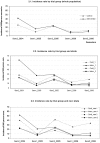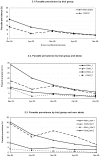Long-Lasting Insecticidal Hammocks for controlling forest malaria: a community-based trial in a rural area of central Vietnam
- PMID: 19809502
- PMCID: PMC2752990
- DOI: 10.1371/journal.pone.0007369
Long-Lasting Insecticidal Hammocks for controlling forest malaria: a community-based trial in a rural area of central Vietnam
Abstract
Background: In Vietnam, malaria remains a problem in some remote areas located along its international borders and in the central highlands, partly due to the bionomics of the local vector, mainly found in forested areas and less vulnerable to standard control measures. Long Lasting Insecticidal Hammocks (LLIH), a tailored and user-friendly tool for forest workers, may further contribute in reducing the malaria burden. Their effectiveness was tested in a large community-based intervention trial carried out in Ninh Thuan province in Central Vietnam.
Methods and findings: Thirty villages (population 18,646) were assembled in 20 clusters (1,000 individuals per cluster) that were randomly allocated to either the intervention or control group (no LLIH) after stratification according to the pre-intervention P. falciparum antibody prevalence (<30%; > or =30%). LLIH were distributed to the intervention group in December 2004. For the following 2 years, the incidence of clinical malaria and the prevalence of infection were determined by passive case detection at community level and by bi-annual malariometric surveys. A 2-fold larger effect on malaria incidence in the intervention as compared to the control group was observed. Similarly, malaria prevalence decreased more substantially in the intervention (1.6-fold greater reduction) than in the control group. Both for incidence and prevalence, a stronger and earlier effect of the intervention was observed in the high endemicity stratum. The number of malaria cases and infections averted by the intervention overall was estimated at 10.5 per 1,000 persons and 5.6/100 individuals, respectively, for the last half of 2006. In the high endemicity stratum, the impact was much higher, i.e. 29/1000 malaria cases and 15.7 infections/100 individuals averted.
Conclusions: LLIH reduced malaria incidence and prevalence in this remote and forested area of Central Vietnam. As the targets of the newly-launched Global Malaria Action Plan include the 75% reduction of the global malaria cases by 2015 and eventually the elimination/eradication of malaria in the long term, LLIH may represent an additional tool for reaching such objectives, particularly in high endemicity areas where standard control tools have a modest impact, such as in remote and forested areas of Southeast Asia and possibly South America.
Trial registration: ClinicalTrials.gov NCT00853281.
Conflict of interest statement
Figures



Similar articles
-
Malaria transmission and vector behaviour in a forested malaria focus in central Vietnam and the implications for vector control.Malar J. 2010 Dec 23;9:373. doi: 10.1186/1475-2875-9-373. Malar J. 2010. PMID: 21182774 Free PMC article.
-
Social determinants of long lasting insecticidal hammock use among the Ra-glai ethnic minority in Vietnam: implications for forest malaria control.PLoS One. 2012;7(1):e29991. doi: 10.1371/journal.pone.0029991. Epub 2012 Jan 12. PLoS One. 2012. PMID: 22253852 Free PMC article.
-
Rapid decrease of malaria morbidity following the introduction of community-based monitoring in a rural area of central Vietnam.Malar J. 2009 Jan 5;8:3. doi: 10.1186/1475-2875-8-3. Malar J. 2009. PMID: 19123932 Free PMC article.
-
Efficacy of topical mosquito repellent (picaridin) plus long-lasting insecticidal nets versus long-lasting insecticidal nets alone for control of malaria: a cluster randomised controlled trial.Lancet Infect Dis. 2016 Oct;16(10):1169-1177. doi: 10.1016/S1473-3099(16)30148-7. Epub 2016 Jun 29. Lancet Infect Dis. 2016. PMID: 27371977 Clinical Trial.
-
The impact of mass screening and treatment interventions on malaria incidence and prevalence: a retrospective analysis of a malaria elimination programme in eastern Myanmar, and systematic review and meta-analysis.Malar J. 2025 May 8;24(1):148. doi: 10.1186/s12936-025-05392-9. Malar J. 2025. PMID: 40340798 Free PMC article.
Cited by
-
A systematic review of factors influencing participation in two types of malaria prevention intervention in Southeast Asia.Malar J. 2021 Apr 20;20(1):195. doi: 10.1186/s12936-021-03733-y. Malar J. 2021. PMID: 33879186 Free PMC article.
-
Plasmodium knowlesi and Wuchereria bancrofti: Their Vectors and Challenges for the Future.Front Physiol. 2012 May 1;3:115. doi: 10.3389/fphys.2012.00115. eCollection 2012. Front Physiol. 2012. PMID: 22557977 Free PMC article.
-
Characterizing Types of Human Mobility to Inform Differential and Targeted Malaria Elimination Strategies in Northeast Cambodia.Sci Rep. 2015 Nov 23;5:16837. doi: 10.1038/srep16837. Sci Rep. 2015. PMID: 26593245 Free PMC article.
-
The changing epidemiology of malaria elimination: new strategies for new challenges.Lancet. 2013 Sep 7;382(9895):900-11. doi: 10.1016/S0140-6736(13)60310-4. Epub 2013 Apr 15. Lancet. 2013. PMID: 23594387 Free PMC article. Review.
-
Targeting high risk forest goers for malaria elimination: a novel approach for investigating forest malaria to inform program intervention in Vietnam.BMC Infect Dis. 2020 Oct 15;20(1):757. doi: 10.1186/s12879-020-05476-8. BMC Infect Dis. 2020. PMID: 33059623 Free PMC article.
References
-
- Roll Back Malaria Partnership. The global malaria action plan for a malaria free world. 2008. http://www.rollbackmalaria.org/gmap/index.html.
-
- NIMPE. Annual Report of the National Malaria Control Program in Vietnam: 2007. 2008. NIMPE. Hanoi, Vietnam.
-
- NIMPE Annual Report of the National Malaria Control Program in Vietnam: 2006. 2007. NIMPE. Hanoi, Vietnam.
-
- NIMPE Annual Report of the National Malaria Control Program in Vietnam: 2005. 2006. NIMPE. Hanoi, Vietnam.
-
- Trung HD, Van Bortel W, Sochantha T, Keokenchanh K, Quang NT, et al. Malaria transmission and major malaria vectors in different geographical areas of Southeast Asia. Trop Med Int Health. 2004;9:230–237. - PubMed
Publication types
MeSH terms
Substances
Associated data
LinkOut - more resources
Full Text Sources
Medical
Research Materials

